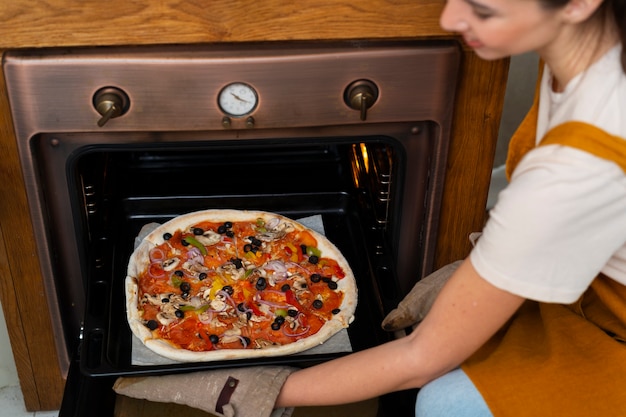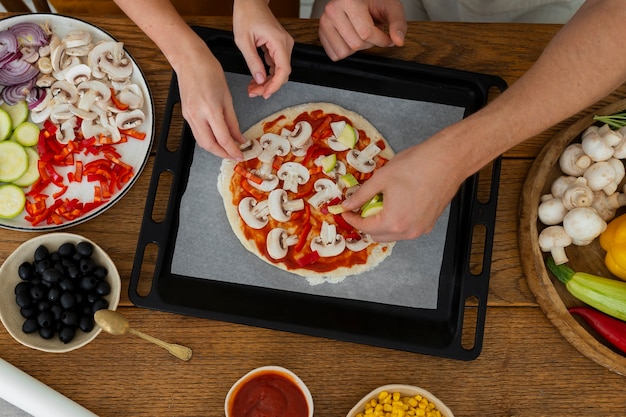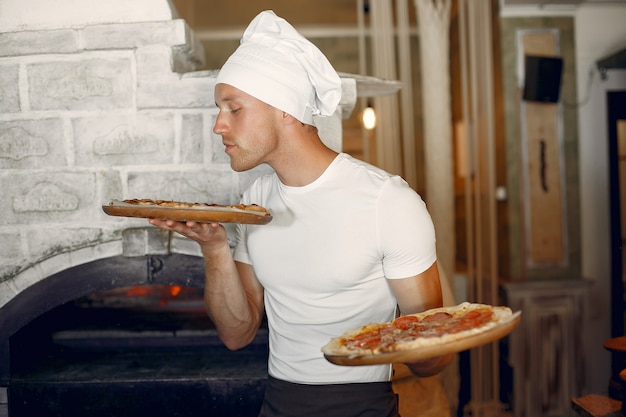The aroma of wood-fired pizza, the satisfying crackle of the crust, the molten cheese – there's something truly magical about a pizza cooked to perfection in a wood-fired oven. But achieving that coveted golden-brown crust, that perfect balance of crispness and chewiness, isn't always easy. It’s a matter of understanding the interplay of temperature, timing, and technique. As someone who's spent countless hours experimenting in my own pizza oven, I've learned a thing or two about perfecting pizza oven cooking time.
This article isn't just about timings; it's a journey into the heart of pizza oven cooking. We'll delve into the science behind crust browning, explore the factors that influence cooking time, and uncover the secrets to consistently producing pizzas that will make your taste buds sing. So, grab your favorite recipe, fire up the oven, and let's get started on our pizza adventure.
(Part 1) Setting the Stage: Understanding Your Pizza Oven

First, we need to understand our primary tool: the pizza oven. Every oven has a distinct personality, and learning its nuances is crucial to unlocking its full potential. This knowledge empowers us to adjust our cooking times and techniques for optimal results.
1.1 The Temperature Tango
Temperature is the single most important factor influencing cooking time. You want the oven hot, really hot, to create that coveted blistering crust. But, like a delicate dance, it's a balancing act. Too much heat and your pizza risks burning before it even has a chance to bake through.
My wood-fired oven, a beast of a machine, thrives at around 450°C (840°F). It's a fiery furnace that delivers a breathtakingly fast cook. My neighbour, however, uses a gas-powered oven that struggles to reach 400°C (750°F). This means he needs to adjust his cooking time accordingly, often opting for a slightly longer bake. So, discover your oven's sweet spot through experimentation.
1.2 The Pizza Pantomime
The pizza stone or steel is another key player in the cooking process. It's the foundation on which your pizza bakes, acting as a heat conductor and ensuring even browning. The type of stone or steel you choose can significantly impact cooking time.
Thicker stones, like those made from traditional Italian terracotta, retain heat for a longer duration. This leads to a slower, more gentle bake. Thinner steel, on the other hand, heats up rapidly but doesn't hold onto the heat for as long. This results in a quicker cook but requires close monitoring to prevent burning.
1.3 The Flour Factor
Don't underestimate the role of flour! It's the backbone of your dough, influencing its hydration and ultimately, how quickly it bakes. Different types of flour have varying protein content, affecting their gluten development and baking properties.
High-protein flours, like the celebrated 00 flour used in traditional Neapolitan pizza, boast a higher gluten content. This translates to a more elastic dough that requires a slightly longer cooking time to achieve that perfect chewiness.
(Part 2) The Art of Preheating: Getting Your Oven Ready

Preheating isn't just a formality; it's a fundamental step in preparing your oven for pizza perfection. A properly preheated oven ensures even heat distribution, enabling consistent browning and preventing hot spots that can lead to uneven cooking.
2.1 The Hot Seat
Before you even think about tossing your dough into the oven, give it a good preheat. Aim for at least 30 minutes, preferably 45 minutes or even an hour. This allows the pizza stone or steel to absorb the heat and reach its peak temperature, ensuring a consistent baking environment for your pizza.
2.2 The Oven's Warm-Up
While your oven preheats, keep an eye on its temperature to ensure even heat distribution. You can achieve this by placing a baking sheet on the middle rack and using a thermometer to monitor the temperature. A consistent reading across the oven is what we're aiming for, preventing hot spots that can burn your pizza before it's fully cooked.
(Part 3) Crafting the Perfect Crust: A Doughy Delight

Before we embark on the pizza-making journey, let's talk dough. It's the canvas on which we'll paint our masterpiece. A well-crafted dough is the foundation of a delicious pizza, providing the perfect balance of chewiness and crispness.
3.1 The Dough's Journey
Start with a high-quality recipe that resonates with your taste and style. My personal favorites include classic Neapolitan dough, known for its thin, airy crust, and sourdough, with its complex flavors and tangy notes. Don't be afraid to experiment with different recipes, finding the one that best suits your preferences.
3.2 The Kneading Ritual
Kneading is a ritual, a transformative process that develops the gluten in the dough. It's a dance of hands and flour, a gentle massage that brings the dough to life. Knead the dough thoroughly, ensuring it becomes smooth and elastic. This crucial step gives the crust its structure and chewiness, allowing it to hold its shape during baking and create that delightful texture we all crave.
3.3 The Restful Rise
Once your dough is kneaded, allow it to rest in a warm place. This is the crucial rise, a time for the yeast to work its magic. It transforms the dough, creating those airy bubbles that give pizza crust its signature lightness and texture. Let it rise until it doubles in size, a testament to the power of time and yeast.
(Part 4) The Pizza Prep: Ready to Rock
With your dough ready, it's time to assemble our culinary masterpiece.
4.1 Stretching and Shaping
Gently stretch or roll out the dough into a circle or rectangle, depending on your desired shape. For Neapolitan-style pizzas, stretching is preferred, allowing for a thin, irregular crust. For other styles, a rolling pin can be used to achieve a more uniform shape.
4.2 The Sauce Symphony
Spread your favorite sauce over the dough, keeping it close to the edge to avoid a soggy crust. A well-balanced sauce, not too thick and not too watery, is key to enhancing the flavor profile of your pizza without compromising the crust's integrity.
4.3 Toppings: A Matter of Taste
Layer on your toppings generously, but remember, moderation is key. Too many toppings can create a soggy crust and prevent it from browning properly. Balance your toppings carefully, ensuring they complement each other and don't overwhelm the flavor of the dough.
(Part 5) Pizza Oven Cooking Time: The Countdown Begins
The moment of truth! It's time to slide our pizza into the fiery embrace of the oven. Let's explore the key factors that determine pizza oven cooking time, ensuring we achieve that perfect golden-brown crust.
5.1 The Size of the Prize
The size and thickness of your pizza have a direct impact on cooking time. A smaller, thinner pizza will bake faster than a larger, thicker one. This is due to the increased surface area exposed to the heat, allowing for faster browning and cooking.
5.2 The Temperature Tipping Point
As we've discussed, the oven temperature is a critical factor. The hotter the oven, the faster the pizza will cook. High heat is essential for achieving that signature crispy crust, but it also increases the risk of burning. This is why understanding your oven's temperature capabilities is crucial.
5.3 The Crust's Character
The type of crust you desire influences cooking time. A thin, crispy crust, like that of a Neapolitan pizza, will bake much faster than a thicker, chewier crust. This is because a thin crust has less dough to cook through, allowing for faster browning and crisping.
5.4 The Toppings' Role
Don't forget about the toppings! Some, like cheese, can take a bit longer to melt and brown. Heavier toppings, like mushrooms or meat, can also affect cooking time, requiring a slightly longer bake. This is why it's important to consider the overall weight and moisture content of your toppings.
(Part 6) A Time for Trial and Error: Experimenting with Pizza Oven Cooking Time
There's no magic formula, no one-size-fits-all guide when it comes to pizza oven cooking time. Each oven is unique, and the way it interacts with your chosen recipe and toppings will vary. It's a journey of experimentation, a dance of trial and error, where we learn the nuances of our ovens and refine our techniques over time.
6.1 The First Bite: Checking for Doneness
After the initial 5-7 minutes of baking, use a pizza peel to gently lift the pizza and check the bottom crust. Is it starting to brown? This is a good sign. The crust should be developing a golden-brown hue, a testament to the oven's heat.
6.2 The Golden Hue
Continue baking, checking the crust every minute or so. We're aiming for a consistent golden-brown color, not a burnt one. Keep an eye on the crust, adjusting the cooking time as needed to avoid over-browning.
6.3 The Cheese Test
As the crust approaches doneness, focus on the cheese. It should be melted and bubbly, with the edges starting to brown. This indicates that the cheese has reached its melting point and is contributing to the overall texture and flavor of the pizza.
(Part 7) Adjusting Your Timing: The Art of Precision
Throughout the baking process, be prepared to adjust your timing based on how your pizza is developing. It's a dynamic process, and your pizza may require a few tweaks to reach its full potential.
7.1 The Hot Spot
If you notice certain areas of the pizza browning too quickly, rotate it to ensure even cooking. This is especially important in ovens with hot spots, which can lead to uneven browning and overcooked areas.
7.2 The Cool-Down Period
If the pizza seems like it's browning too quickly, reduce the oven temperature slightly. This will slow down the cooking process, allowing the cheese to melt and the crust to bake through without burning.
7.3 The Finishing Touches
When the crust is golden brown and the cheese is bubbly, your pizza is ready to come out of the oven. Let it cool for a few minutes before slicing and serving. This allows the crust to firm up slightly, making it easier to slice and preventing the cheese from becoming overly runny.
(Part 8) Pizza Oven Cooking Time: A Cheat Sheet
To provide a starting point for your pizza oven journey, here's a general guide to pizza oven cooking times based on different factors:
| Pizza Size | Crust Type | Oven Temperature | Cooking Time |
|---|---|---|---|
| Small (10") | Thin Crust | 450°C (840°F) | 5-7 minutes |
| Medium (12") | Thick Crust | 400°C (750°F) | 8-10 minutes |
| Large (14") | Deep Dish | 350°C (660°F) | 10-12 minutes |
Remember, these are just general guidelines. The actual cooking time will vary depending on your specific oven, recipe, and toppings. Don't be afraid to adjust your cooking time as needed to achieve pizza perfection.
(Part 9) Pizza Oven Cooking Time: FAQs
Q1: My pizza crust is burning before the cheese melts. What can I do?
This often happens when the oven temperature is too high. Try lowering the temperature by 25°C (50°F) and baking for a few minutes longer. You can also increase the preheating time to ensure the oven is evenly heated.
Q2: My pizza crust is soggy. What went wrong?
A soggy crust is usually caused by too much moisture. Ensure your dough is well-drained and not overly wet. Avoid overloading the pizza with too many watery toppings.
Q3: How can I tell if my pizza is done?
Look for a golden-brown crust, bubbly cheese, and melted toppings. Tap the crust; it should sound hollow, indicating that it's cooked through. If the cheese is still runny and the crust is pale, it needs more time in the oven.
Q4: Can I use a pizza stone in a regular oven?
Absolutely! A pizza stone can help create a crispy crust in a regular oven. Just be sure to preheat the stone for at least 30 minutes before placing your pizza on it.
Q5: What are some tips for achieving a crispy crust?
Here are a few tips to achieve that coveted crispy crust:
- Use a high-quality pizza stone or steel.
- Preheat the oven to the highest temperature possible.
- Don't overcrowd the oven.
- Avoid using too much sauce or toppings.
- Rotate the pizza halfway through baking to ensure even cooking.
With patience, experimentation, and a passion for pizza, you'll become a pizza oven pro in no time. So, crank up the heat, embrace the challenge, and let's bake some pizza magic together!
Everyone is watching

Corn on the Cob: The Ultimate Guide to Perfectly Cooked Ears
Healthy MealsAh, corn on the cob. Just the name evokes images of sunny days, barbecues, and that sweet, juicy flavour that ...

Perfect Pork Roast Oven Cooking Time: A Guide to Delicious Results
Healthy MealsThere's something truly satisfying about a perfectly roasted pork. The aroma alone is enough to make your mout...

Ham Cooking Time: How Long to Bake, Smoke, or Boil a Delicious Ham
Healthy MealsAh, ham. It's a classic, isn't it? A real crowd-pleaser, especially around holidays. And when done right, it'...

Scallops: The Ultimate Guide to Perfect Cooking
Healthy MealsAh, scallops. Those delicate, sweet, and utterly delicious morsels of the sea. They hold a special place in my...

Spaghetti Squash: The Ultimate Guide to Cooking and Serving
Healthy MealsRemember that time you saw spaghetti squash at the supermarket, looking all bumpy and strange, and thought, "W...
